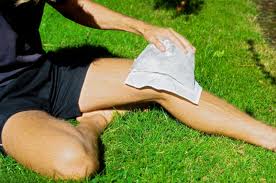Leg pain refers to discomfort and pain in the structures of the leg which may occur as a result of injury due to falls or accidents an irritation or inflammation of the muscles, bones, joints or skin of the leg.
A person with leg pain may experience symptoms such as leg bruising, skin redness, leg swelling, joint swelling, fever, leg deformity and difficulty walking or inability to walk or stand.
This post on leg pains and associated causes, signs, symptoms and treatment is for learning purposes only. To learn to recognize and manage emergencies associated with severe leg pain sign up for first aid and CPR training with a provider near you.
Causes
Serious underlying causes of leg pain may include:
- Acute vascular occlusion
- Bone cancer
- Cellulitis
- Deep venous thrombosis
- Leg fracture
- Lyme disease
- Lymphangitis
- Osteomyelitis
- Peripheral vascular disease
- Rhabdomyolysis
- Rheumatoid arthritis
- Septic arthritis
- Slipped capital femoral epiphysis
- Spinal cord tumor
- Spinal stenosis
Mild causes of leg pain may include:
- Arthritis
- Baker’s cyst
- Chondromalacia patella
- Fibrous dysplasia
- Gouty arthritis
- Herniated disk
- Hypokalemia
- Lliotibial band syndrome
- Leg contusion
- Leg muscle strain
- Leg sprain
- Muscle cramp
- Osteoarthritis
- Osteomalacia
- Osteoporosis
- Paget’s disease
- Polymyalgia rheumatica
- Polymyositis
- Post-phlebitic syndrome
- Restless leg syndrome
- Rickets
- Sciatica
- Shin splints
- Thrombophlebitis
- Varicose veins
Uncommon causes of leg pain include:
- Beriberi
- Buerger’s disease
- Cancer
- Leg compartment syndrome
- Lupus
- Lyme disease
- Multiple myeloma
- Neuromuscular disorders
- Peripheral neuropathy
- Perthes disease
- Polycythemia vera
- Pseudogout
- Reactive arthritis
- Rhabdomyolysis
- Tibial stress fracture
Risk fractures
Risk factors associated with leg pain include:
- Alcoholism
- Congestive heart failure
- Diabetes
- Elderly
- Falls
- Family history of arthritis
- Overuse injury
- Obesity
- Peripheral neuropathy
- Previous leg injury
- Persistent stress to a joint
- Tick bite – Lyme disease
Signs and symptoms
Signs and symptoms of leg pain include:
- Led bruises
- Leg swelling
- Leg pain
- Worsening pain with movement
- Deformed leg
- Joint swelling or knee swelling
- Inability to walk
- Inability to stand
- Leg tenderness
- Leg stiffness
- Fever
Treatment
Treatment for leg pan may depend on the underlying cause. Common treatment options for leg pan include:
1. Cold compresses
- Apply cold compress on the affected region using ice wrapped in moist towel
- Avoid applying ice directly to the skin
- Apply cold compress for 20-30 minutes for every 2 hours after the injury
2. Rest
- Use a walker, crutches or a cane to support walking
3. Elevate
- Elevate the affected leg above heart level, whenever possible, especially while resting
4. Compress using an elastic wrap. Re-wrap after 2-3 hours
5. Apply a cast or splint
6. Take nonsteroidal anti-inflammatory medication or acetaminophen for pain
7. Antibiotics may be prescribed for skin infection such as Lymphangitis and cellulitis
8. Antibiotics will be prescribed for joint infections such as septic arthritis
9. Leg pain may be treated with physical therapy
10. Severe fractures or broken bones may require surgery to repair the damage
11. Take prescribed medication as directed by your health care provider and avoid skipping doses
When to seek medical attention
See your doctor if any of the following problems occur with leg pain:
- Leg numbness
- Leg weakness
- Leg pain lasts for more than a week
- Inability to walk or stand
- Worsening pain in the leg
- Worsening leg tenderness
- Worsening leg swelling
- Severe bruising of the leg
- Worsening skin redness
- Worsening skin pain
- Red streaks o the skin
- Drainage of pus from the leg wound
- Changes in skin color of the leg – leg becomes pale or cold
- Fever
Learn More
To learn more about minor and major emergencies associated with leg pain sign up for first aid and CPR courses with a St Mark James training provider.

